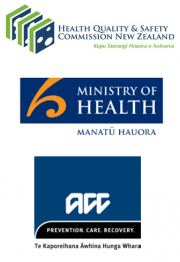Mō mātou

Pressure injuries (also known as pressure ulcers) are a major cause of preventable harm for patients using health care services (including hospital, aged residential care and home care).
These injuries usually develop over ‘bony’ parts of the body due to sustained pressure, or pressure combined with shear and/or friction.
Pressure injuries cause physical symptoms, feelings of anger and blame, and reduce quality of life through pain, infection, delayed healing, altered body image, depression, and increased mortality and morbidity. The human toll on patients, carers and their families/whānau should not be underestimated.
These injuries also carry connotations of neglect and mismanagement on the part of health professionals.
Evidence shows most pressure injuries are preventable – early identification of people at risk and subsequent effective management needs to be a high priority for all care providers to reduce harm.
There are key actions that are globally recognised and promoted to reduce the risk and impact of pressure injuries. For example, the SSKIN bundle provides a useful approach to ensure that no prevention element is missed (more information is available here). It includes considering or undertaking the following:
- Surface – provide a supportive and pressure relieving surface
- Skin Inspection – undertake regular checks for discolouration and pain on bony prominences (such as hips and heels) and under or around medical devices
- Keep moving – change position often
- Incontinence– keep skin dry and clean
- Nutrition – eat healthily and drink plenty of fluids.
Pressure injuries impact the New Zealand health system by increasing patients’ length of stay, ACC treatment injury claims and care costs.
An emerging priority for a national programme to prevent pressure injuries?
In late 2014, the Health Quality & Safety Commission, Accident Compensation Corporation (ACC) and the Ministry of Health engaged KPMG to investigate the economic and social harm caused by pressure injuries, and advise on the likely benefits of a national prevention programme. The report is available on the Commission website and has been used to inform next steps for a joint agency approach to pressure injury prevention.
Joint agency approach
ACC, the Commission and the Ministry are working together and with the sector to reduce pressure injuries in New Zealand.
ACC is leading the development of guidance, resources and tools for the sector on the prevention, assessment and treatment of pressure injuries. In the 2016–17 financial year they developed guiding principles to inform the sector’s pressure injury prevention activities (the guiding principles document can be found here).
In November 2021 ACC released the Pressure Injury in Spinal Cord Injury Consensus Statement, endorsed by eight organisations. In August 2022 it released the Te Reo Māori Pressure Injury in Spinal Cord Injury Consensus Statement. These are both part of ACC’s continued support to people living with a spinal cord injury and have enabled the development of this agreed best practice for preventing, treating and managing pressure injuries in Aotearoa.
ACC has continued to support the development of the Pressure Injury in Spinal Cord Injury Consensus Statement in 2023 by translating it into various languages as part of an ongoing commitment to support people living with a spinal cord injury. https://www.acc.co.nz/resources/#/subcategory/152
In 2020 ACC in collaboration with the New Zealand Wound Care Society, Ministry of Health and the Commission developed a full set of ‘No pressure’ pressure injury prevention resources. They include a patient-focused flyer in 15 languages, three posters, and a classification chart for clinicians. These are available on the New Zealand Wound Care Society website and printed copies can be ordered at no cost from ACC’s online ordering system.
The Ministry is providing clinical oversight and support for engagement with clinical leaders. An ongoing focus is developing a culture and infrastructure that supports pressure injury prevention, promoting a multidisciplinary approach and improving collaboration between sectors. The Ministry, through HealthCERT, has focused on pressure injury management in aged residential care and more information can be found in HealthCERT's March 2018 bulletin. A report from auditing between 1 January 2016 and 31 March 2017 demonstrates the profile of pressure injury prevention and management in aged residential care. The report is available on the Ministry of Health website: https://www.health.govt.nz/system/files/documents/publications/pressure-injuries-aged-residential-care.pdf.
The Commission is leading two pieces of work:
- ensuring a consistent approach to measurement of pressure injury prevalence
- promoting patient stories and case studies for the purpose of raising the profile of the impact and harm from pressure injuries.
Useful links
- Prevention and Treatment of Pressure Ulcers: Full Clinical Practice Guideline (to purchase) or Quick Reference Guideline (to download)
- New Zealand Wound Care Society (NZWCS)
- Australian Wound Management Association (AWMA)
- First, Do No Harm (Northern region patient safety campaign)
- Patient stories about pressure injury
